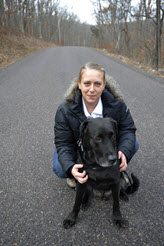From Somber Sunsets to a Strengthened and Courageous Spirit

“I remember a day when I just stood there and stared at the sunset in the middle of Baghdad, and I was like ‘this is where I’m going to die, and there’s really nothing I can do about it.’”
Army veteran Angie Peacock has come a long way since that time in her life, when anticipating death was the ominous thread that snaked its way through her days.
Now, her day-to-day feelings are the opposite. She knows she will make it through any challenge thrown her way thanks to the courage she has developed through her commitment and involvement with Wounded Warrior Project® (WWP).
But it wasn’t a simple journey.
From the beginning of Angie’s first deployment, high stress was standard. Lots of driving and equipment repair structured her days, but part of her job also involved worrying about bombs and improvised explosive devices (IEDs).
“You don’t just go to work; there’s no such thing as an ordinary day,” she said.
Along with her stress and anxiety, Angie began to have physical health ailments that wracked her body, and compounded the intensity of her mental health struggles.
A gastrointestinal infection brought her down to a scary 100 pounds. Her already stressed, exhausted body was assailed by nosebleeds, high blood pressure, palpitations, and fainting. All of this led to depression…then panic attacks.
“I kept thinking ‘I’m going to die in Iraq. I’m going to die from being sick or I’m going to die from getting shot or blown up.’ We all knew death was a very real possibility at any moment.”
Despite this, her ambition to serve never wavered. She kept fighting, fulfilled missions, and called on extraordinary focus to follow orders to the letter.
“I just prayed I wouldn’t die. That’s really all you can do,” she said with a sigh.
After getting medevaced when her health was at a desperate point, Angie’s post-traumatic stress disorder (PTSD) was just beginning, but she also considers it the start of her healing journey.
“Once I was home, I just woke up scared of everything,” Angie said. “It feels like you’re in a constant state of panic. You react to things you don’t want to react to. Noises make you jump; you have nightmares. You feel out of control.”
Angie also explained part of her PTSD and depression included crying for no reason, but when she needed to cry, she couldn’t. Everything got jumbled up, she said.
Self-medicating to escape the pain of her combat experience started her on the dark path to addiction: she began abusing prescriptions and opiates as her battle for sanity and peace spiraled out of control.
“I tried to kill myself multiple times,” Angie said. “I told myself ‘I’m going to keep mixing drugs until it works, and let it be over.’”
Luckily, Angie found out about Wounded Warrior Project, and she decided to sign up online. “I wanted to get my life back and get involved with some things that would make me feel better,” Angie said. “WWP was on that list of things.”
Still, she wasn’t totally comfortable on this path to healing, even though it was something she wanted for herself.
“When I first joined WWP, I felt like I didn’t belong because I wasn’t visibly wounded,” Angie said, a perspective common among many wounded veterans who do not display visible wounds. It is an unfortunate misconception that keeps many from getting the help they need … and deserve.
Angie recalls: “A WWP staff member said, ‘you have PTSD, right? That’s a wound. Many of the injured warriors we serve have PTSD.’ After he said that, I felt relief.”
With that relief came a sense of belonging that eludes so many warriors once they return to civilian life. It can be difficult knowing how to overcome isolation and rekindle bonds similar to those formed in the military. That’s where WWP’s free programs and services play a role in the recovery process.
“Everyone was instantly like a family member. I felt like for the first time since I was out of the military, I had a family, and I didn’t have to explain myself because everyone else just knows,” Angie said. “It was like a whole world opened up that I didn’t even know existed.”
WWP’s Physical Health and Wellness programs are what resonated with Angie the most. She started doing equine therapy, and that was a pivotal experience to get her body back after enduring years of physical pain. After three years of that, she progressed steadily by starting yoga then moving into CrossFit®.
“I had this rewarding feeling of knowing my body can do more than I think it can, and I’m not as sick as I think I am,” Angie said. “It’s pretty amazing, considering where I started.”
Angie saw the power of the mind-body connection; she said exercise significantly helped her overcome her mental health hurdles.
“I became passionate because it made all my symptoms disappear, and it was as if my problems didn’t exist. It eliminates depression and PTSD. I want others who are struggling with the same things to know they have the power to manage them through exercise. Exercise is medicine.”
Meditation provided yet another key element that propelled Angie toward a full recovery.
“I was heavily medicated by psychiatry, and it made me worse, but I didn’t know it at the time,” Angie said. “It took me 13 years, but I finally weaned off of everything. I was on 17 medications, and now I’m on zero. I feel like I would have saved a lot of years if I would have just practiced meditation and mindfulness. Healing from depression and PTSD involves more than just taking a pill.”
Eventually, WWP asked Angie to become a peer mentor. Once she overcame her initial hesitance, it came very naturally. She also formed a veterans group when she went to St. Charles Community College because she recognized the importance of an outlet for veterans to bond with each other.
“The veterans groups helped me stay engaged and connect with like-minded people,” Angie said. “When there wasn’t a veterans group at my college, I felt a void. Sometimes you have to fill a gap if you see it, so that’s what I noticed and filled.”
That is only one of many examples of how Angie has used the leadership skills she honed in the military to enrich her civilian life. Angie is almost done with her bachelor’s degree in psychology now and plans to pursue her master’s in social work next so she can assist veterans with PTSD, traumatic brain injury (TBI), addiction, and recovery.
“Healing is not easy,” she said. Once upon a time, those words would have been uttered warily; now, there is triumph. “I’ve come a long way and walked through a lot of fear, and I’m just looking forward to that next chapter where I can help people.”
Angie has already helped a lot of people and has been an example to many, and that’s why she won the WWP George C. Lang Award for Courage in 2015. She was surprised that she was the recipient.
“When they told me, I felt there was no way I deserved that. WWP said I was always helping people, but that’s just who I am and what I do,” she explained tearfully. “It was a big thank you for being who I am. I’m not 100 percent healed or perfect, but that word ‘courage’ is imprinted on my life.”
The George C. Lang Award is given to someone who exemplifies humility and advocates passionately behind the scenes for all service members – especially those with both visible and invisible wounds.
“We are so resilient,” Angie said. “Our spirit is stronger than we think it is. We are all warriors, and that is just who we are, whether we are on the battlefield, or at home trying to heal.”

